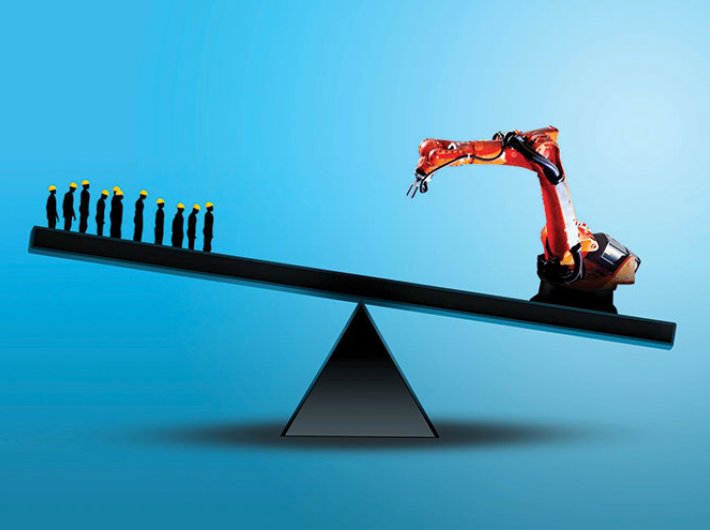Experts envisage an exciting era of robots, AI, drones, virtual reality and Internet of Things. But are we really prepared for Industrialisation 4.0, as the current transition is being called?
Sometimes, when the change is too rapid and dramatic, you might not know whether it is really happening. It is understandable, considering the fact that you simply don’t recognise it. Without you knowing, however, a dramatic change is already taking place.
When Klaus Schwab talks about the fourth industrial revolution, it is not going to be too difficult for you to just look away and stay in total denial. You can repeat it to yourself again and again: “How can it be happening while 1.2 billion people have no access to electricity around the world according to International Energy Agency? It seems like a far-away future from now. More than anything, the electricity grid is so fragile, and all these new devices or technology functions relying on the electricity. The fourth industrial revolution might never arrive!”
Nonetheless, like it or not, it’s already going on. Artificial Intelligence (AI) is not something you can only see in sci-fi films. You don’t have to look too far. It’s right there in your smartphone. Siri (iOS) and Google Now (Android) are all intelligent digital personal assistants.
The ‘Stitch Fix’ in USA is another such example. You don’t have to look at the photos of clothes or dresses just like you do when you buy clothes online. Here, just download the app and enter some personal likes and dislikes, body size, etc., and they will send you five boxes of clothes from which you can choose to keep some. But how can they send boxes of clothes whose photos you didn’t even see? It’s because they have adopted AI in their system and, based on the analysis of your likes and dislikes, they pick and choose what you might like.
Remember AlphaGo winning against the world Korean champion of Chinese Go, Sedol Lee, last year. Now we have this Deep Learning, through which AlphaGo can learn from its own mistakes. It’s already crept into our daily lives. IBM Watson Healthcare is also available in some hospitals. This is not to say that AI is perfect at the moment. Far from it, there are many related issues, such as regulation on the adoption of IBM Watson Healthcare, since it is still developing. But this doesn’t mean that this research should be stopped, either. That’s the reason why some say that AI may not replace humans, but rather will augment human capabilities.
Smart factories are also popping up. In smart factories, machines and equipment communicate with one another, and without human involvement, they detect the problems and fix them. However, since it is expensive to transform the factories into smart factories, only 20% factories in the world can afford to do so. One of the Korean startups, UlalaLAB, has succeeded in developing a less expensive platform. It has developed ‘Wim Factory,’ and, without spending a lot of money on replacing the equipment, they can transform any factory into a smart factory with the cloud, machine learning, data analysis, monitoring and transmitting all those analysed data to your smart devices so that you can take some appropriate measures about defectively produced goods. It maximises efficiency and productivity, saving costs.
Zume Pizza, another startup in USA, has adopted pizza robots in their system. This robot can make 288 pizzas per hour, and Zume Pizza uses AI to find out customers’ preferences. They do not need the same number of human labourers as before, so by saving the cost, they can use even better and fresher ingredients for pizzas.
So what do all these stories tell us? Although we are well aware that the fourth industrial revolution is still in its infancy, we also need to be prepared for the future. Among others, according to Oxford University, 47% of the current jobs will disappear in the next 25 years. According to futuristspeaker.com, 2 billion jobs will disappear by 2030. How many jobs will disappear and exactly when is not the point here. We are already going through a lot of changes. So knowing about the 4th industrial revolution and the possible changes thereby might be vital for our future generations. Should we educate our children with some useful skills now, which will be useless in the near future? Do we know what are we going to expect and prepare them accordingly? Which way is better? Honestly, we’ll never know until we are there. However, it might be too late to prepare yourself or our younger generations after all those changes arrive.
Let me share an interesting example from Korea. Nowadays, people talk about Computational Thinking (CT). It is well known in Korea that many other countries such as the UK, Finland, Estonia and USA, emphasise on the importance of coding and digital education. It might look too severe to teach children programming when they are only 10 years old. But their generations might be totally different. Just look at your smartphones; 15 years ago we used basic mobile phones only. Now so many people use smartphones. So naturally, our children are already used to technologies like smartphones, laptops, internet, 3D printing, drones, robots, AI. Teaching them programming or coding may not sound so unusual.
This does not mean that coding is everything and we should start as early as possible. This is just part of the preparation for the future. According to the projection of the World Economic Forum 2016, 7.1 million jobs will be lost by 2020, and 2 million new jobs will pop up. Get this: almost all new jobs will be related to computers or programming. Many Korean parents worry about the future of their children. So we hurry up to adopt coding education into the national curriculum. This doesn’t mean that everyone will become a programmer in the future, but it’ll be just like a basic thing you will need to know in the future. There was a time when people were impressed by those who knew how to use word processors. But now no one will be impressed by it. That’s why we are in such a hurry to adopt coding, programming or CT into our education programme.
Nevertheless, there are many challenges. It is not even clear whether we have sufficient qualified coding teachers or not. And also, what age is the most appropriate to begin to learn coding. Is younger, the better? In a competitive country like Korea, so many parents are already teaching their children coding, logical thinking, science and math for their survival in future. But this is not only about Korea. Japan also wants its children to be more creative and stronger with logical thinking, and so it has decided to make programming a compulsory subject in schools, starting 2020.
But why do these countries care about CT so much? It’s because they need to prepare themselves for the worst scenario. That’s the reason why all these governments are adopting CT. After all, education is the key for survival in the future. The preparation cannot be done only by private sectors; private sectors and public sectors should get together to discuss how to proceed with the education, infrastructure, internet, big data, R&D on AI, robotics, acceleration of innovative startups, etc. Otherwise, you might be left behind while you are in total denial of all these possible disruptive changes to come a lot sooner than expected.
Some economists and naysayers argue that there is no such thing as the 4th industrial revolution due to lack of numerous resources. But, you never know. Education and preparation for the future shouldn’t be at the mercy of just assumptions.
For this, the public sector and the private sector need to talk to each other. If the government, big companies, and startups are going to collaborate on this, the government should listen to the private sector carefully. The government can do something about wrong or out-of-date regulations or obstacles that hinder many creative people from going into the direction of the innovation. Big companies can use their huge network and resources to contribute to the innovation. Innovative startups can tap into all those resources that both the government and the big companies offer. If we can build this natural ecosystem for innovation, we are one step closer to the good preparation for the 4th industrial revolution age. The government needs to listen to innovative people, not forcing them or suppressing through ridiculous systems, old-fashioned paperwork, and not-up-to-date regulations.
Don’t be mistaken to think that the 4th industrial revolution is all about fancy robots, AI, drones, VR/AR (virtual reality/augmented reality), IoT (Internet of Things), 3D printing or smart factories or farms only. This is more about innovation in our lives. This is going to change our conventional ways of thinking and living in many ways. Start from education. Help people to be well aware of what to expect. Spread the words. Make the atmosphere where people are motivated to do the preparation. Otherwise, without us knowing, we will be dinosaurs not knowing we will be left behind.
Director, Global Cooperation & Global Marketing Gyeonggi Innovation Center, Korea
(The column appears in the May 1-15, 2017 issue)



